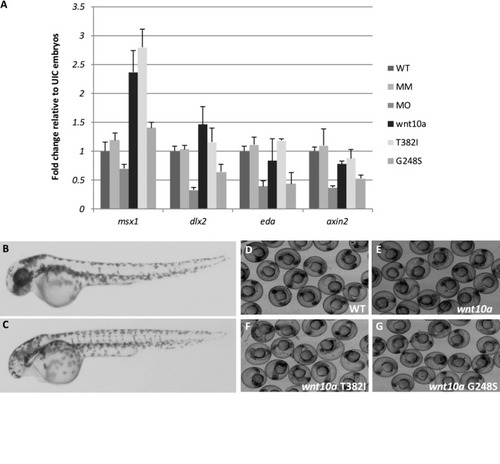
Perturbation of wnt10a expression results in altered expression of additional tooth development genes at tooth bud formation stage (2 dpf). (A) Quantitative RT‐PCR analyses of msx1, dlx2b, eda, and axin2 genes in WT, mismatch‐MO injected (MM), wnt10a‐MO injected (MO), wnt10a RNA injected (wnt10a), and wnt10a mutant RNA with T328I and G248S mutations (corresponding to T357I and G213S in humans). No differences were observed in the expression of those genes between WT and MM‐injected embryos, whereas knockdown of wnt10a led to significantly decreased expression of dlx2b, eda, and axin2 (P = 0.001). In contrast, overexpression of wnt10a resulted in increased expression of all four genes (P < 0.02), although with significant differences only for msx1 (P = 0.01) and axin2 (P = 0.02). Injection of mutant wnt10a RNAs also perturbed expression of msx1, dlx2b, eda, and axin2, particularly the G248S mutant (0.002 < P < 0.02). Target gene expression was normalized to the expression of beta‐actin used as endogenous control. Fold changes were calculated in relation to controls by the 2−∆∆Ct method and analyzed using Student's t test. P‐values ≤0.05 were considered statistically significant. (B,C) Overexpression of Wnt10a leads to a small/no eyes phenotype in wnt10a RNA‐injected fish (C) in comparison to WT (B) at 2 dpf. Embryos not injected with any RNA (D), injected with 1 pg zebrafish wnt10a RNA (E), 1 pg wnt10a RNA with T382I mutation (F), and 1 pg wnt10a RNA with G248S mutation (G).
|

